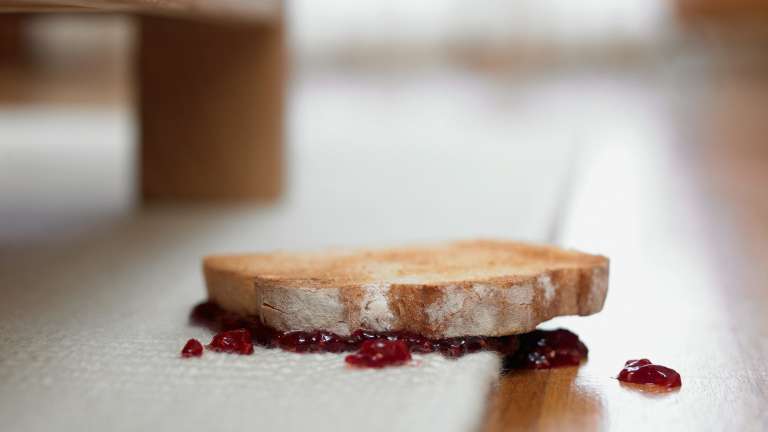Has your slice of pizza ever tumbled tragically to the floor? Did you hesitate for a moment, maybe even count to five, before picking it up and taking a bite? You’re not alone. The “5-second rule” – the idea that food dropped on the floor is safe to eat if retrieved within five seconds – is a familiar mantra in kitchens and dining rooms worldwide. But is there any scientific truth to this seemingly harmless rule? The answer, unfortunately, is a bit more complicated than a simple yes or no.

Image: www.msn.com
The 5-second rule is a deeply ingrained cultural phenomenon, a playful coping mechanism for those moments of culinary misfortune. It’s a topic that’s sparked countless debates and fueled a healthy dose of kitchen humor. But beneath the lightheartedness lies a question of food safety and the potential for microbial contamination. As we delve into the science behind the 5-second rule, we’ll explore the factors that influence the transfer of bacteria and discover whether those five precious seconds really make a difference in the battle against invisible microbes.
The Microbial Mayhem: Bacteria on the Floor
A Microcosm of Life
Our floors are, in essence, miniature ecosystems teeming with a diverse cast of microorganisms. Bacteria, viruses, fungi, and more make their homes in the dust, crumbs, and general grime that accumulate on our surfaces. The types and quantities of microorganisms present vary depending on the type of flooring, the cleaning habits of the household, and the overall environmental conditions.
The Transfer Game: From Floor to Food
When food drops, it becomes a potential landing pad for these microorganisms. Whether bacteria transfer from the floor to the food depends on a number of factors. These include the type of surface the food falls on, the type of food itself, the length of time the food remains on the surface, and the presence of moisture.

Image: www.smh.com.au
Debunking the 5-Second Myth: Time is Not the Only Factor
The Truth About Time
While the 5-second rule may seem like a reasonable compromise, the duration of contact is not the sole determinant of food safety. Bacteria and other microbes don’t adhere to a strict schedule before transferring to your food. In fact, studies have shown that bacteria can transfer to food within milliseconds of contact.
The Role of the Surface
The type of floor surface also significantly influences the transfer of bacteria. A smooth, non-porous surface, like tile or linoleum, will have fewer crevices for microbes to hide in and therefore present a lower risk of transfer. Conversely, rough surfaces like carpets or wood floors tend to harbor more bacteria and increase the likelihood of contamination.
The Nature of the Food: A Sticky Situation
A Matter of Moisture
Moist foods, such as bread, cakes, and sticky candies, are more susceptible to bacterial contamination than dry foods. This is because moisture provides a more hospitable environment for bacteria to grow and thrive. The longer moist food remains on the floor, the greater the likelihood of bacterial transfer.
The Power of Texture
The texture of the food also plays a role. Foods with a rougher surface, such as potato chips or pretzels, are more likely to pick up bacteria from the floor compared to smooth foods like pasta or rice.
Beyond Bacteria: Other Contaminants
While bacteria are the most common concern, other contaminants like viruses, mold, and parasites can also reside on floors. These can pose health risks if transferred to food and ingested. The presence of these contaminants depends on the specific environment and the hygiene practices in the household.
The 5-Second Rule: A Balancing Act
The 5-second rule is ultimately a complex interplay of factors. While the rule may be lighthearted, it’s important to acknowledge that there is a real risk of food contamination when dropping food on the floor. Time is not the only factor, and the nature of the food, the surface it falls on, and the presence of other contaminants play critical roles.
The Bottom Line
While a quick retrieval might seem innocuous, the 5-second rule is a myth. No scientific evidence supports the idea that a five-second window makes food safe to eat after falling on the floor. The decision to eat dropped food is a personal one, but it’s important to weigh the potential risks of microbial contamination, especially for individuals with compromised immune systems or children. To ensure safe food practices, the best strategy is to avoid dropping food on the floor in the first place or to dispose of it if contamination is likely.
The Future of Food Safety: Technology and Education
As our understanding of food safety evolves, technology and education play crucial roles in preventing contamination. Studies on the transfer of bacteria and the development of more sophisticated cleaning techniques are ongoing. Moreover, raising awareness about safe food handling practices through educational programs can help reduce the risk of foodborne illnesses.
Dropping Food On The Floor 5 Second Rule
A Call to Action
So, the next time your food takes a tumble, consider the facts. The 5-second rule may be a fun anecdote, but it’s time to ditch the myth and embrace a more informed approach to food safety. Make informed choices about what you eat, and keep your kitchen and dining areas clean. By combining scientific understanding with responsible practices, we can all contribute to a safer and healthier food environment.






